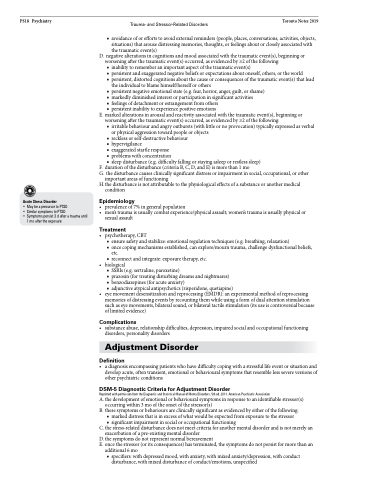Page 1182 - TNFlipTest
P. 1182
PS18 Psychiatry
Trauma- and Stressor-Related Disorders Toronto Notes 2019
■ avoidance of or efforts to avoid external reminders (people, places, conversations, activities, objects, situations) that arouse distressing memories, thoughts, or feelings about or closely associated with the traumatic event(s)
D. negative alterations in cognitions and mood associated with the traumatic event(s), beginning or worsening after the traumatic event(s) occurred, as evidenced by ≥2 of the following:
■ inability to remember an important aspect of the traumatic event(s)
■ persistent and exaggerated negative beliefs or expectations about oneself, others, or the world
■ persistent, distorted cognitions about the cause or consequences of the traumatic event(s) that lead
the individual to blame himself/herself or others
■ persistent negative emotional state (e.g. fear, horror, anger, guilt, or shame) ■ markedly diminished interest or participation in significant activities
■ feelings of detachment or estrangement from others
■ persistent inability to experience positive emotions
E. marked alterations in arousal and reactivity associated with the traumatic event(s), beginning or worsening after the traumatic event(s) occurred, as evidenced by ≥2 of the following:
■ irritable behaviour and angry outbursts (with little or no provocation) typically expressed as verbal or physical aggression toward people or objects
■ reckless or self-destructive behaviour
■ hypervigilance
■ exaggerated startle response
■ problems with concentration
■ sleep disturbance (e.g. difficulty falling or staying asleep or restless sleep)
F. duration of the disturbance (criteria B, C, D, and E) is more than 1 mo
G. the disturbance causes clinically significant distress or impairment in social, occupational, or other
important areas of functioning
H.the disturbance is not attributable to the physiological effects of a substance or another medical
condition
Epidemiology
• prevalence of 7% in general population
• men’s trauma is usually combat experience/physical assault; women’s trauma is usually physical or
sexual assault
Treatment
• psychotherapy, CBT
■ ensure safety and stabilize: emotional regulation techniques (e.g. breathing, relaxation)
■ once coping mechanisms established, can explore/mourn trauma, challenge dysfunctional beliefs,
etc.
■ reconnect and integrate: exposure therapy, etc.
• biological
■ SSRIs (e.g. sertraline, paroxetine)
■ prazosin (for treating disturbing dreams and nightmares)
■ benzodiazepines (for acute anxiety)
■ adjunctive atypical antipsychotics (risperidone, quetiapine)
• eye movement desensitization and reprocessing (EMDR): an experimental method of reprocessing memories of distressing events by recounting them while using a form of dual attention stimulation such as eye movements, bilateral sound, or bilateral tactile stimulation (its use is controversial because of limited evidence)
Complications
• substance abuse, relationship difficulties, depression, impaired social and occupational functioning disorders, personality disorders
Adjustment Disorder
Definition
• a diagnosis encompassing patients who have difficulty coping with a stressful life event or situation and develop acute, often transient, emotional or behavioural symptoms that resemble less severe versions of other psychiatric conditions
DSM-5 Diagnostic Criteria for Adjustment Disorder
Reprinted with permission from the Diagnostic and Statistical Manual of Mental Disorders, 5th ed. 2013. American Psychiatric Association
A. the development of emotional or behavioural symptoms in response to an identifiable stressor(s) occurring within 3 mo of the onset of the stressor(s)
B. these symptoms or behaviours are clinically significant as evidenced by either of the following: ■ marked distress that is in excess of what would be expected from exposure to the stressor
■ significant impairment in social or occupational functioning
C. the stress-related disturbance does not meet criteria for another mental disorder and is not merely an exacerbation of a pre-existing mental disorder
D. the symptoms do not represent normal bereavement
E. once the stressor (or its consequences) has terminated, the symptoms do not persist for more than an
additional 6 mo
■ specifiers: with depressed mood, with anxiety, with mixed anxiety/depression, with conduct
Acute Stress Disorder
• May be a precursor to PTSD
• Similar symptoms to PTSD
• Symptoms persist 3 d after a trauma until
1 mo after the exposure
disturbance, with mixed disturbance of conduct/emotions, unspecified


